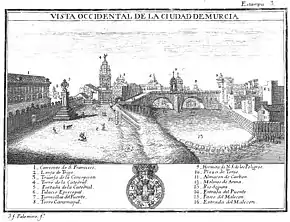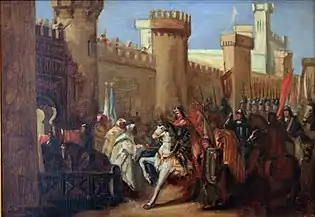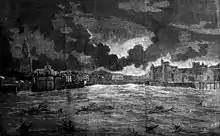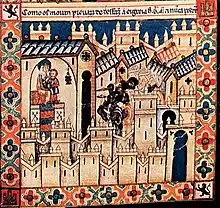History of Murcia
The documented history of Murcia traces back at least to the Middle Ages, after Madinat Mursiya was built by Andalusi Emir Abd al-Rahman II in the 9th century, while it is suggested the city was erected over a previous settlement of Roman origin.

Middle Ages
Madinat Mursiya was reportedly founded circa 825 upon the will of Umayyad Emir Abd al-Rahman II (other sources place its foundation by 831),[1] in parallel to the destruction of neighbouring city of Eio. However, particularly on the light of the archeological evidence of earlier buildings with Christian symbology, there is an historiographical consensus on it being a re-foundation over an earlier Roman settlement tracing back to the 4th or 5th century AD.[2]
The city prospered during the Caliphal era. Following the dismemberment of the Caliphate of Córdoba that ensued from the Fitna of al-Andalus, the city was conquered in the 1010s by Jayran Al-'Amiri,[5] a slav eunuch and former servant of Almanzor who soon left to Almería, placing Zuhayr al-Amiri as governor in the city.[6] After the death of the former, the whole territory was annexed in 1038 by Abd-al-Aziz al-Mansur,[6] ruler of Valencia.
The taifa of Murcia was conquered by Muhammad ibn Aisha on behalf of the Almoravid Empire in June 1091.[7] As the Almoravid Empire retreated, Abu ʿAbd Allāh Muḥammad ibn Saʿd ibn Mardanīš (Rey Lobo in Christian chronicles) established a new taifa in the mid-12th century, lasting from 1147 to 1172. During his reign Ibn Mardanis allied with Castile to counter the Almohad expansion.
In 1228, Ibn Hud, an Andalusi chieftain, rebelled against the Almohad Empire, entering the city of Murcia on 4 August 1228, establishing a new emirate (the third Taifa of Murcia), ruled by the Banu Hud.

By 1240 the taifa was increasingly atomised, with several cities split from the nominal authority of the emir in the city of Murcia, who still claimed authority over the full jurisdiction.[9] Before the triple military threat posed by Castile, Aragon and Granada, the Murcian Emir Muhammad al-Dawla opted to negotiate a treaty with the Castilian King Ferdinand III.[10] After the 1243 Treaty of Alcaraz was reached, the city and the rest of the taifa became a vassal state of the Crown of Castile. As a progressive breach of the conditions abided in the treaty of Alcaraz ensued, discontent increased among the Muslim population, leading to a full-blown insurrection, with the rebels in Murcia joining the 1264 Múdejar revolt. After the intervention of Aragon in 1265, the rebels surrendered the city to forces commanded by Jaime I of Aragon on 2 February 1266; the city was returned to his son-in-law Alfonso X of Castile by the middle of that year. Following the quelling of the rebellion, Alfonso X granted Murcia a charter and privileges similar to those of Seville in 1266.[13]
Alfonso de la Cerda donated the Kingdom of Murcia to Jaime II of Aragon on 21 January 1296 in exchange for help vis-à-vis his challenge for the Castilian throne.[14] The city remained under Aragonese control for eight years, until the delivering of the city signed on 16 November 1304,[15] in compliance with the Treaty of Torrellas. The Castilian monarchs entrusted wide competences to a senior officer called the Adelantado Mayor over the whole Kingdom of Murcia (then a borderland of the Crown of Castile, nearing Granada and Aragon). The territory was to become subject of a nobiliary struggle for the political power between the lineage of Don Juan Manuel and the Fajardo family for much of the Late Middle Ages.[16]
The city of Murcia suffered its first plague epidemic in 1348; reruns of the plague ensued in 1380 and 1395,[17] with the 1395 outbreak decimating half the city population.[17] Plague outbreaks of lesser magnitude continued to take place in the 15th century (also in the 16th century).[18]
Early modern period
The 1648 plage outbreak was particularly virulent in Murcia, reportedly having close to a 50% mortality rate.[19] The last major plague epidemic in Spain affected Murcia in 1677.[20]
Late modern period

On 14 October 1879, a major river flood, the Riada de Santa Teresa, caused havoc in the city. The Segura reached a flow of 1,900 m3/s in the city, leaving up to 761 deaths.[21]
Population
| Year | Population[22] | |
|---|---|---|
| 1530 | 11,677 | |
| 1591 | 15,165 | |
| 1787 | 65,515 | |
References
- Citations
- López Martínez 2015, p. 316.
- López Martínez 2015, p. 316–317.
- Corti 2002, p. 72.
- Corti, Francisco (2002). "Retórica visual en episodios biográficos reales ilustrados en las cantigas de Santa María" (PDF). Historia. Instituciones. Documentos. Seville: Universidad de Sevilla. 29: 76.
- Gaspar Remiro 1905, p. 93.
- Gaspar Remiro 1905, p. 103.
- Gaspar Remiro 1905, p. 141.
- López Martínez 2015, p. 394.
- López Martínez 2015, p. 395–396.
- Torres Fontes 1987, p. 6; 12.
- Sáinz de la Maza Lasoli 1997, p. 273.
- Torres Fontes 1978, p. 120.
- Gómez-Guillamón Buendía, Antonio. "Las luchas nobiliarias por el poder: Manueles vs Fajardos". www.regmurcia.com.
- Hernández Franco 1981–1982, p. 104.
- Hernández Franco 1981–1982, p. 105.
- Hernández Franco 1981–1982, p. 105–106.
- Hernández Franco 1981–1982, p. 103–104.
- Díaz & Porcel 2014, p. 2.
- Vilalta 2003, p. 26
- Bibliography
- Gaspar Remiro, Mariano (1905). Historia de Murcia Musulmana. Zaragoza: Tip. de Andrés Uriarte.
- Díaz, Asunción; Porcel, Gregorio (2014). "Inundaciones en la Región de Murcia en los inicios del siglo XXI". Biblio 3W. XIX.
- Hernández Franco, Juan (1981–1982). "Morfología de la peste de 1677-78 en Murcia" (PDF). Estudis: Revista de historia moderna (9): 101–130. ISSN 0210-9093.
- López Martínez, Carmen (2015). Los mudéjares del Reino de Murcia en el tránsito del dominio castellano al aragonés (1243-1305) (PDF). Madrid: Universidad Nacional de Educación a Distancia.
- Navarro, Julio; Jiménez, Pedro (2016). Murcia, la ciudad andalusí que contempló Alfonso X (PDF). Murcia: Productos Continental. ISBN 978-84-617-4815-0.
- Sáinz de la Maza Lasoli, Regina (1997). "Los santiaguistas del reino de Murcia durante la ocupación aragonesa (1296-1304)" (PDF). Anales de la Universidad de Alicante. Historia Medieval. Alicante: University of Alicante (11): 273–299. doi:10.14198/medieval.1996-1997.11.15.
- Torres Fontes, Juan (1978). "Los Fajardo en los siglos XIV y XV" (PDF). Miscelánea Medieval Murciana. University of Murcia (4). doi:10.6018/j4801. hdl:10201/16395.
- Torres Fontes, Juan (1987). "Evolución del Concejo de Murcia en la Edad Media" (PDF). Murgetana. Murcia: Real Academia Alfonso X el Sabio (71): 5–47. ISSN 0213-0939.
- Vilalta, María José (2003). "'Ciudades rurales' en la España Moderna: el protagonismo de las continuidades" (PDF). Revista de Demografía Histórica. 21 (1): 15–43. ISSN 1696-702X.
